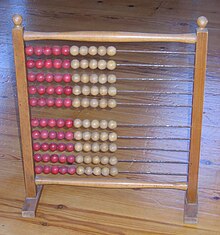Abacus
An abacus is an old tool used for arithmetic. It is still used in some parts of the world, and it is well suited for use in shops and street markets. Sometimes blind people use an abacus, because they can feel the numbers easily. The most common abacuses work by moving beads on rods.[1][2]



Abacuses can do addition, subtraction, multiplication, division. They can be used to find the square root of whole numbers. Expert abacus users can sometimes do math faster than basic calculators.
There is a common Chinese abacus. This abacus is split into two kinds of basic rows, the top is for the "5"s, and the bottom is for the "ones". There are one or two beads in the top rows, and four or five beads in the bottom ones. For example, 8 is one bead on top and 3 below, because 5 + 3 = 8. Every column represents a different digit.
Etymology change
The use of the word abacus dates from before 1387 AD, when the word was got from Latin to describe a sandboard abacus. The Latin word came from ancient Greek ἄβαξ (abax) which means something without base, or (improperly) any piece of rectangular board or plank.
Both abacuses' and abaci are used as plurals. The user of an abacus is called an abacist (soft or hard 'c').
Japan change
There is a Japanese version of the abacus called the 'soroban'. It works in essentially the same way.
Other websites change
General and historical articles change
- Abacus Photos and Images Archived 2015-10-09 at the Wayback Machine
- Abacus
- Roman abacus
Tutorials change
- Manual de uso del Abaco Japonés Soroban Archived 2006-05-24 at the Wayback Machine
- Min Multimedia
- Suan Pan Archived 2001-02-21 at the Wayback Machine
- Abacus: Mystery of the Bead - an Abacus Manual
Abacus curiosities change
References change
- ↑ Boyer, Carl B. (1991). A history of mathematics. Uta C. Merzbach (2nd ed. [rev.] ed.). New York: Wiley. ISBN 0-471-54397-7. OCLC 23823042.
- ↑ Instruments of science : an historical encyclopedia. New York: Science Museum, London, and National Museum of American History, Smithsonian Institution, in association with Garland Pub. 1998. ISBN 0-8153-1561-9. OCLC 36817134.